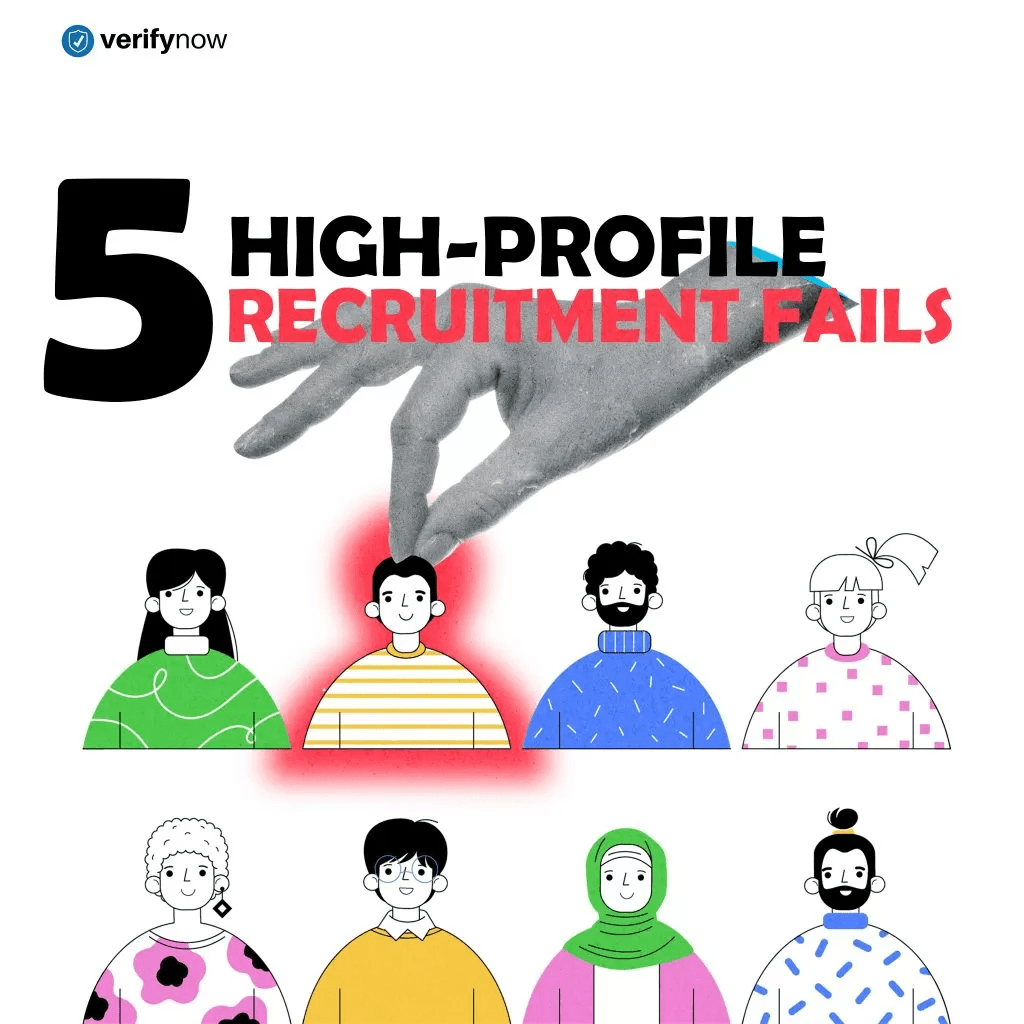Any hiring manager will tell you that staffing is one of the most important aspects of running a successful company. After all, it’s your employees who are responsible for keeping the wheels turning and the customers happy.
So, when it comes time to add new members to your team, it’s important to focus on getting the recruitment process right.
Luckily, there are quite a few things you can do to ensure you’re developing a recruitment strategy that works well for your business or team. This could be done by hiring a professional recruitment agency, conducting background screening, or introducing trial shifts. Or all of the above.
But one of the best things you can do is learn from your peers and don’t make the same recruitment mistakes they have. Learn what not to do and improve your strategy from there. The same applies to your own recruitment mistakes—don’t make them again and your chances for success will be greater.
Here are five high-profile recruitment fails that you can learn from.
1. The Telstra CTO that wasn’t a “Dr”
In 2016, Telstra’s Chief Technology Officer, Vish Nandlall, was abruptly fired from the company. The move came as a surprise to many, as Nandlall had been with Telstra for a little under two years.
While the specific reasons for his dismissal have never been made public, there have been numerous media reports pointing to the fact that Nandlall allegedly misled the major corporation by claiming that he had an MBA from Harvard.
Of course, Nandlall denied the claims, but Fairfax confirmed that in addition to the issue with the MBA, he had also been misrepresenting the fact that he had a PhD, often crediting his presentations, interviews, and conferences as either “Vish Nandlall, PhD” or “Dr Vish Nandlall”.
This was not only misleading, but it also called into question his credibility and expertise. When someone in a position of authority and trust inaccurately represents their credentials, it damages the trust that others have in them and the organisation they represent.
Unfortunately, it seems as if the organisation failed to verify these credentials. This is an important example of why it’s important to conduct employment and integrity checks before hiring your next employee. It can happen to organisations of any size and business maturity stage.
Employment history verification and reference checks can help employers to verify that an applicant is who they say they are and that they have the necessary skills, experience, and qualifications for the job. They can also help employers identify any potential red flags that may indicate that an applicant is not being truthful about their background or qualifications.
In addition, employment and integrity checks can provide employers with peace of mind knowing that they’ve taken all the necessary steps to ensure that their candidates are trustworthy and reliable.
2. Myers’ Myopic Mistake
In 2014, department store giant Myer laid off a new high profile recruit just a few days after his induction period started because his references were called into question. The references turned out to be fake, and the new employee had lied about his experience.
Just seven days before he was fired, Myer triumphantly announced that they were able to secure Andrew Flanagan – the former managing director and vice-president of Inditex Group (which owns fashion giant Zara) – as their new GM of Strategy and Business Development.
Unfortunately, Mr. Flanagan didn’t see the end of his first day on the job because it turned out that the Inditex Group had no idea who he was. The claim that Mr. Flanagan worked in procurement positions at Walmart and Homeworld Group, as well as as the COO of Tesco, was not verified either.
According to the recruitment agency, they conducted thorough reference checks but were misled by incorrect employment history information.
This incident highlights the importance of either considering hiring a third-party screening company that specialises in streamlining employment screening or conducting your own thorough background checks on new recruits.
In today’s competitive job market, it can be tempting to take shortcuts when screening candidates. But, as the Myer case shows, skipping key steps in the hiring process can come back to bite you.
3. The Australian Bureaucrat Jailed For Deception
In September 2017, former Chief Information Officer at the South Australian Department of Premier and Cabinet Veronica Hilda Theriault faced charges of deception, dishonestly handling documents, and abuse of public office. The charges came after evidence emerged suggesting that she misrepresented various aspects of her CV and her references.
As the position carried a significant annual pay package and access to sensitive information, the charges prompted an investigation by the Independent Commissioner Against Corruption into the recruitment processes within the South Australian Premier’s Department.
Hiring the right people is crucial for any business, but is especially important given this is a senior public service position in a state department, where trust in government is critical to society’s functioning. The screening process should be rigorous and thorough so that only suitably qualified, experienced, and reputable team members are onboarded.
4. Swiss Guard to the Pope Turned Out To Be No Saint
The Dean of a Houston Catholic business school in the USA, the University of St. Thomas, was recently forced to resign after it came to light that he allegedly lied about having several degrees.
Following an investigation into his teaching style, Mario Enzler, who had previously served as a Swiss Guard to Pope John Paul II and met Mother Teresa, falsely claimed to have a PhD from a university in Italy that doesn’t even offer doctorates. In addition, the college he allegedly attended turned out to be a high school.
This information came to light when other professors at the university started questioning the way he taught his classes – which probed them to look into his background. Not only was he not qualified to teach, he held no business degrees that rendered him an appropriate candidate to be appointed the Dean of the Cameron School of Business.
This would have had a profound impact on the students enrolled in his courses and on the faculty as a whole.
The story once again highlights the need to implement thorough background checks as part of your recruitment strategies—especially in the education and training sector. After all, teachers are responsible for imparting knowledge and shaping young minds. So, it’s essential to ensure that they have the necessary qualifications and experience.
5. The Policeman Who Needed Policing
A local council was caught in a situation where a staff member was hired based on falsified qualifications. Despite having served several years as a detective constable in the United Kingdom, Peter Ravenscroft felt it necessary to exaggerate his experience, lie about his qualifications, and falsify various career achievements to secure a high-paying job for the Frankston City Council in Victoria.
Thanks to misrepresentation, the council was paying more than $450,000 for someone who was far from qualified to execute the duties of that position. The lies continued when he was hired as the assistant director of strategic investigations at the Victorian Ombudsman, who also wasted an almost $200,000 salary on someone who could not have executed the duties required of him.
Both these departments unfortunately lost valuable expertise and resources due to this misrepresentation.
He was lucky to escape jail time, but the fact that this is a criminal offence doesn’t seem to be stopping people from making these fraudulent statements about their qualifications and job experience.
This is why it’s become more important now than ever to start introducing employment screening strategies so that you can avoid bad hires and controversy that adversely affect your organisation’s reputation in the community.
Key Takeaways
As the business world grows more competitive, the need for high-performing teams has never been greater. Fortunately, there are a number of strategies that businesses can use to encourage team building and create an environment conducive to high performance.
Some of these strategies include developing an effective accountability model implementing automated processes; fostering relationships amongst colleagues; and incorporating a comprehensive background screening strategy.
By taking these steps, businesses can create teams that are better equipped to face challenges and drive results. In today’s competitive landscape, investing in high-performing teams is essential for any business that wants to succeed.



